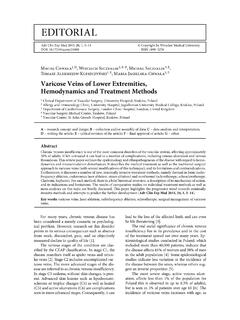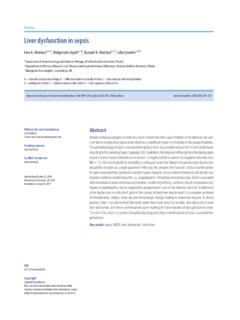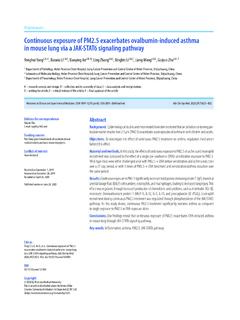Transcription of Cerebral small vessel disease: A review
1 Cite asChojdak- ukasiewicz J, Dziadkowiak E, Zimny A, Paradowski B. Cerebral small vessel disease : a review . Adv Clin Exp Med. 2021;30(3):349 356. 2021 by Wroclaw Medical University This is an article distributed under the terms of theCreative Commons Attribution Unported (CC BY )( )Address for correspondenceJustyna Chojdak- ukasiewiczE-mail: sourcesNone declaredConflict of interestNone declaredReceived on July 26, 2020 Reviewed on October 31, 2020 Accepted on December 6, 2020 Published online on March 25, 2021 AbstractCerebral small vessel disease (CSVD) is the most common , chronic and progressive vascular disease .
2 The changes affect arterioles, capillaries and small veins supplying the white matter and deep structures of the brain. It is the most common incidental finding on brain scans, especially in people over 80 years of age. Magnetic resonance imaging (MRI) plays a key role in the diagnosis of CSVD. The nomenclature and radiological phenotypes of CSVD were published in 2013 based on the unified position of the so-called Centres of Excellence in Neurodegeneration. The disease is characterized by a diverse clinical and radiological picture.
3 It is primarily responsible for stroke incidents, gait disturbances, depression, cognitive impairment, and dementia in the elderly. The CSVD contributes to about 20% of strokes, including 25% of ischemic strokes and 45% of dementias. common causes of CSVD include arteriosclerosis, Cerebral amyloid angiopathy (CAA), genetic small vessel angiopathy, inflammation and immune-mediated small vessel diseases, and venous col-lagenosis. There is no causal treatment and management is mainly based on combating known risk factors for cardiovascular disease (CVD).Key words: amyloidosis, Cerebral small vessel disease , white matter hyperintensities, lacunar infarcts, microbleedsReviewsCerebral small vessel disease : A reviewJustyna Chojdak- ukasiewicz1, A,D, Edyta Dziadkowiak1,B, Anna Zimny2,B, Bogus aw Paradowski1,E,F1 Department of Neurology, Wroclaw Medical University, Poland2 Department of General Radiology, Interventional Radiology and Neuroradiology, Wroclaw Medical University, PolandA research concept and design; B collection and/or assembly of data; C data analysis and interpretation.
4 D writing the article; E critical revision of the article; F final approval of the articleAdvances in Clinical and Experimental Medicine, ISSN 1899 5276 (print), ISSN 2451 2680 (online) Adv Clin Exp Med. 2021;30(3):349 356J. Chojdak- ukasiewicz et al. Cerebral small vessel disease350 IntroductionCerebral small vessel disease (CSVD) is a chronic, pro-gressive disorder of arterioles, capillaries and small veins supplying the white matter and deep structures of gray matter; it is characterized by a diverse clinical picture and specific changes in neuroimaging and neuropatho-logical investigations of the ,2 The changes affect small vessels, 50 400 um in diameter, and lead to dam-age of the white matter in subcortical brain structures.
5 The CSVD is a dynamic disease process not limited to ce-rebral vessels but affecting the whole body. It is clinically heterogeneous and constitutes the most common cere-brovascular disease (CVD).1 The CSVD is responsible for about 20% of all strokes, including 25% of ischemic strokes and 45% of vascular ,3 The nomenclature and radiological phenotypes of CSVD were published in 2013 based on the unified position of the so-called Centres of Excellence in The STRIVE protocol (STandards for ReportIng Vas-cular changes on nEuroimaging) sets diagnostic standards and assesses individual radiological phenotypes of CSVD and their clinical consequences (Table 1).
6 4 The CSVD is typically recognized on both brain magnetic resonance imaging (MRI) and computed tomography (CT) scans, but MRI has greater sensitivity and specificity. A reliable radiological assessment is only possible with at least T MRI including the following sequences: FLAIR (fluid-at-tenuated inversion recovery), T2* (gradient recalled echo T2*-weighted images) or SWI (susceptibility-weighted imaging), T1, and DWI (diffusion-weighted imaging). Figures 1 5 present MRI findings of CSVD occurs 6 10 times more often than Silent brain infarcts are the most frequently identified incidental findings on brain scans, especially in older people.
7 As many as 25% of people over 80 years of age have had 1 silent ,7 It has been estimated that for every symptomatic stroke, there are about 10 silent brain The prevalence of CSVD increases with age, with no significant sex Prevalence of white matter Table 1. Types of Cerebral small vessel disease (CSVD) according to STRIVE after Wardlaw et of CSVDD escriptionRecent subcortical infarctsfresh, small (less than 20 mm in axial section) ischemic lesions with respect to perforating arteries, whose radiological features or clinical signs and symptoms indicate their formation in the few weeks before the test; best seen in the DWI sequence.
8 These changes are hypointense in the T1 sequence, hyperintense in the T2 and FLAIR sequences, and isointense in the GRE-T2 sequenceLacunae of presumed vascular originround or oval subcortical lesions 3 15 mm in diameter, filled with fluid, with cerebrospinal fluid-like signal; these lacunae correspond to history of acute Cerebral infarction or bleeding from the area of vascularization of the perforating artery; the lesions are characterized by a distinctive image in the FLAIR examination; each lesion is a cavity filled with cerebrospinal fluid and surrounded by a hyperintense rim; they are isointense in the DWI sequence, hypointense in the FLAIR and T1 sequences, and hyperintense in the T2 sequenceWhite matter hyperintensities symmetric regardless of size; hyperintense in the T2, FLAIR and GRE-T2 (gradient-echo T2) sequences; isointense in DWI; and hypointense in T1 Widened perivascular spaces (Virchow Robin perivascular spaces)mostly seen in basal ganglia <2 mm in size.
9 They usually accompany hyperintense lesions of the white matter and lacunar condition but not brain atrophy; the lesions are hyperintense in T2 sequences, hypointense in FLAIR and T1 sequences, and isointense in the GRE-T2 sequenceCerebral microbleeds (CMBs) small , homogeneous lesions <10 mm in diameter, characterized by the blooming effect ; the lesions are best seen in the gradient-echo T2 sequence (hypointense lesions); in the T2, T1 and FLAIR sequences, they are isointense; microbleeds correspond to hemosiderin-loaded macrophages that are present in the perivascular spaceBrain atrophybrain atrophy in the context of CSVD is considered only when the patient has not suffered a stroke or head injuryDWI diffuse-weighted imaging; FLAIR fluid-attenuated inversion 1.
10 A. Acute lacunar infarction on DWI; B. White matter hyperintensities (WMHs) on the FLAIR image; C. Old lacunar infarction seen on the FLAIR image as a dark fluid-filled cavity surrounded by a hyperintense rim; D. Enlarged perivascular spaces on a T2-weighted image; E. Multiple microbleeds bilaterally within basal ganglia and thalamiAdv Clin Exp Med. 2021;30(3):349 356351hyperintensities increases from about 5% for people aged 50 years to nearly 100% for people aged 90 Also, the prevalence of Cerebral microbleeds increases from for people aged 45 50 years to about 36% for people aged 80 89 yea There is a noticeable population variability: CSVD lesions are more common in the Chinese popula-tion, where lacunar strokes account for 46% of ischemic 2.






